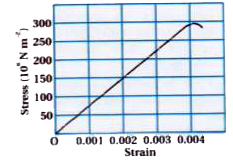Draw Stress - Strain curve. Show Yield point and Fracture point.Solution in Kannada
Beyond 'B' the yielding point, the wire extends but does not return to the initial state when the deforming force is removed. 'F' is the breaking point.
'EF' allows the materials to be malleable and 'DE', ductile.

Topper's Solved these Questions
- PU BOARD MODEL QUESTION PAPER (WITH ANSWERS)Book:SUBHASH PUBLICATIONChapter:PU BOARD MODEL QUESTION PAPER (WITH ANSWERS)Exercise:EXERCISE (PART - D)
Explore 14 Videos
- PU BOARD MODEL QUESTION PAPER (WITH ANSWERS)Book:SUBHASH PUBLICATIONChapter:PU BOARD MODEL QUESTION PAPER (WITH ANSWERS)Exercise:EXERCISE (PART - B)
Explore 8 Videos
- PHYSICAL WORLDBook:SUBHASH PUBLICATIONChapter:PHYSICAL WORLDExercise:TWO MARKS QUESTIONS WITH ANSWERS
Explore 30 Videos
- SUPER MODEL QUESTION PAPER (WITH ANSWERS) Book:SUBHASH PUBLICATIONChapter:SUPER MODEL QUESTION PAPER (WITH ANSWERS) Exercise:PART - D
Explore 11 Videos
Similar Questions
What is v-t graph? Derive the expression x=V0t+1/2at2 using v-t graph.
View SolutionName the two Physicists who achieved the unification of electricity and magnetism.
View SolutionMathematics is the language of physics. Justify the statement.
View SolutionShow that v=v0+at by graphical method.
View SolutionFig., shows the stress-strain curve for a given materal. What are (a) Young's modulus and (b) approximate yield strength for this material?
View SolutionFigure shows the relationship between tensile stress and strain for a typical material. Below proportional point A, stress is directly proportional to strain which means Young's moudulus (Y) is a constant. In this region the material obeys Hooke's law. Provided the strain is below the yield point 'B' the material returns to its original shape and size when the force is removed. Beyond the yield point, the material retains a permancnt deformation after the stress is removed. For stresses beyond the yeld point, the material exhibit plastic flow, which means that it continues to elongate for little increases in the stress. Beyond C a local constriction occurs. The material fractures at D (i.e. breaking point). The graph below shows the stress-strain curve for 4 different materials. Material which is good for making wires by stretching is
View SolutionThe point on the stress-strain curve at which the strain begins to increase even without any increase in the stress is
View SolutionDraw Stress - Strain curve. Show Yield point and Fracture point.
View SolutionWrite stress-strain curve for a metal. What is proportional limit and yield point ?
View SolutionFig., shows the stress-strain curve for a given materal. What are (a) Young's modulus and (b) approximate yield strength for this material?
View SolutionStress And Strain|Hookes Law#!#Stress Strain Curve
View SolutionFigure shows the strain-stress curve for a given material. What are (a) Young's modulus and (b) approximate yield strength for this material ?

View SolutionFigure show the stress-strain curve for a given material. What are (a) Young's modulus and (b) approximate yield strength of the material?
View Solution(A): Silver is a ductile material
(R): For a ductile material yield point and Breaking point are seperated by larger distance than for Brittle materials on the stress-strain curve.
View SolutionFigure show the stress-strain curve for a given material. What are (a) Young's modulus and (b) approximate yield strength of the material?

View SolutionDraw the stress-strain graph of a loading wire. Mark the following points : i) Elastic limit ii) Fracture point iii) Plastic region iv) Elastic region
View Solution

